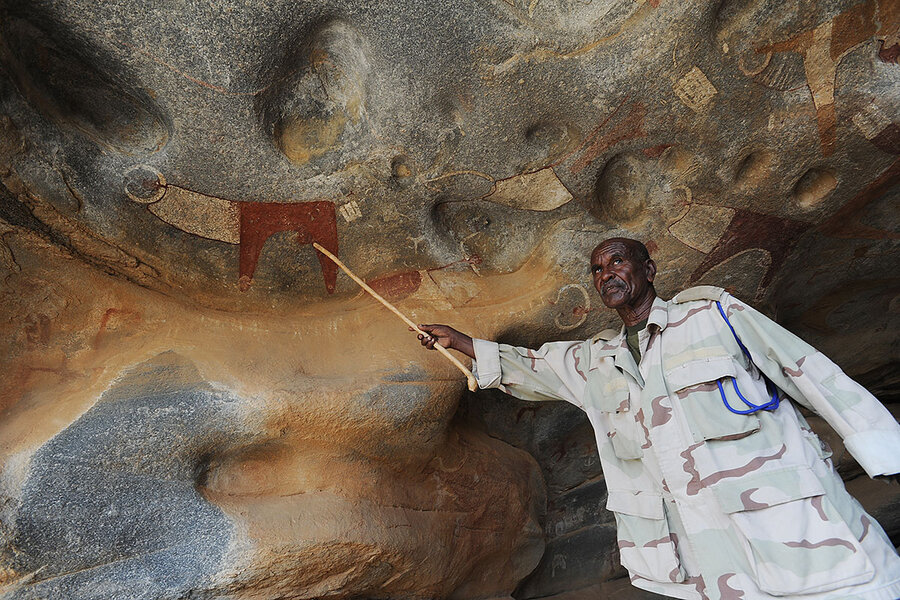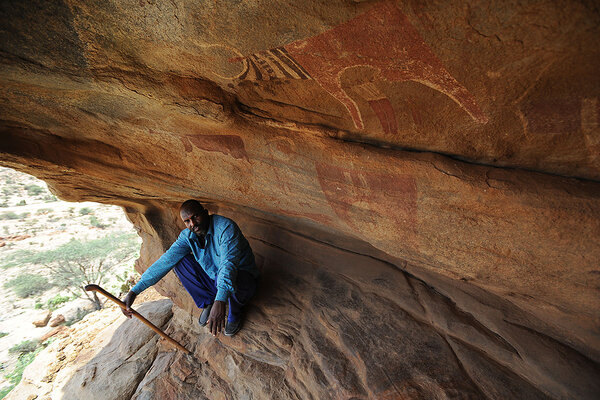Five-thousand-year-old rock art is tucked into an outcropping 40 miles northeast of Hargeisa, the capital of this breakaway region of Somalia. But its ambiguous political status has made protecting the site especially challenging.
LAAS GEEL, SOMALILAND—Hidden in the Somali desert, beneath stunning, ancient rock cave paintings, the thin trail of a snake traces a winding line across the dust. A few strands of once-protective barbed wire are pushed to the side; goat tracks abound.
Somaliland’s most prized archaeological treasures – which locals fearfully called “the place of the devils” for centuries – could not be more remote.
Exposed to the elements, the colors have changed since caretaker Musa Abdi Jama first saw them at a distance in 1969. Back then, everyone in the local villages thought the place was haunted. No one visited.
Today, the aging pastoralist laughs at the memory of the myths he heard about the place as a child – passed on to him as they were from one generation to the next around dinnertime family campfires.
“We believed it was drawn by the devil with blood,” he says, “and believed that when we slaughtered a goat for protection, the devil would come and suck the blood from the sand.”
The uniformed Mr. Jama uses a cane to point out features of the Neolithic paintings: the hunters with bows and arrows; long-horned cattle, antelope, giraffes, and elephants; and women giving water to a dog – being “more kind” than the hunters, he says.
Striking in their red and dun colors and more than 5,000 years old, the cave paintings are tucked away in the overhangs of a nondescript rock outcropping. The cave lies at the end of a miles-long track across inhospitable desert, 40 miles northeast of Hargeisa, the capital of the remote Horn of Africa nation of Somaliland – a de facto state that declared independence from Somalia in 1991. The nation, whose territory was once a British colony, has remained largely peaceful, even as the rump Somalia state to the south has been torn by conflict for decades.
But Somaliland remains internationally unrecognized – and that ambiguous political status is a key difficulty preventing Laas Geel paintings and other Somali treasures from being listed as a United Nations World Heritage site, which would provide a major boost in protecting and promoting this historical heritage.
Universal value?
To be added to UNESCO’s World Heritage list, a site must be of “outstanding universal value” and meet at least one of 10 criteria. Somaliland’s rock art appears to meet at least two of those, including bearing “a unique or at least exceptional testimony to a cultural tradition or to a civilization which is living or which has disappeared.”
A listing would provide new protections, along with prestige on par with the more-famous paintings in France’s Lascaux or Spain’s Altamira caves.
Yet the Somalia government in Mogadishu has yet to ratify UNESCO’s 1972 World Heritage Convention – despite registering intent to do so last year. No Somali site was included in the 21 new cultural sites designated in early July when the World Heritage Commission met in Krakow, Poland.
The new designations include caves and Ice Age art in the Swabian Jura mountains in Germany, and three sites in Africa, including Eritrea, Angola, and South Africa.
Official recognition and protection status is required by UNESCO if sites such as Laas Geel are to be preserved, says Saad Ali Shire, the foreign minister of Somaliland.
“It’s not just important to Somaliland; it’s a global heritage. It belongs to me as much as it belongs to you,” says Dr. Shire. “If we lose it, it’s not just a loss to Somaliland, but a loss to everyone.”
A visit to Laas Geel
Today, when caretaker Jama speaks about protection at Laas Geel, he is not speaking about a fear of demons. Instead, he worries about deterioration of a site that could attract visitors and put Somaliland on the archaeological map.
The day after Jama pointed a French archaeological team to the site in 2002 – the first outsiders to “discover” the caves, and date them to 5,000 years old – he says he received a surprise message from the Somaliland president, telling him: “You are responsible for this area.”
Honored by the request, Jama had to overcome his nervousness after a lifetime of hearing the stories. The next day was his first time to actually visit the cluster of caves and their rich paintings up close.
These days, a sign warns visitors about the fragility of the ancient art, instructing that they not be touched. But there is little else protecting the site except a single metal bar across the rocky road leading to the outcroppings.
Several UNESCO teams have visited, officials here say, but every bid to add the site to a global list has been thwarted by the fact that neither the United Nations nor any country recognizes Somaliland.
History rubbed away
Shire advocates for UNESCO recognition at Laas Geel, but also notes that more than 100 sites of historical importance have been identified in Somaliland, including cave paintings, centuries-old cities and ports, and ancient cemeteries. “We need to have a strategy to preserve this and other sites, and also do some exploration,” he says. “There is a lot of valuable heritage to be discovered.”
Those words are echoed by Somali anthropologist Najib Shunuf, who has studied the rock art and advocates for its wider recognition.
“It’s one of the rarest places in the world, where you can find such a very well decorated place. We are lucky to have something of that standard in Somaliland [that] looks like it was painted two years ago. It’s like going to a gallery in France or New York,” says Mr. Shunuf.
“There are already some deterioration of the colors, [and] many tourists going there with no knowledge,” says Shunuf. “People are touching it, people are sitting on it, and using flash photography, which can damage it in the long run.”
Cracks in the walls let in dirt and water, causing further damage, he adds. Some harm has even come from amateur archaeologists, who have scratched some paintings with knives.
Back at the rock caves, Jama points out how a layer of dust has obscured some of the images. Some grit is shaped in the form of rivulets, from water that once trickled here.
“It’s different from the day it was discovered; then it was bright colors, but not now,” says Jama. During a recent visit from the French team that first brought the art to world attention 15 years ago, “they were surprised because they knew it [then] was very colorful,” he says.
Jama shows where a protective wall had once been built. But today, the ancient paintings face the desert, exposed at their high perches along the rock outcropping.
“The rain, the wind and the dust can wash it out,” says Jama. “It needs more protection.”
Source: https://www.csmonitor.com



